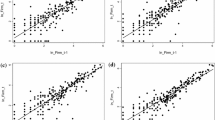Abstract
The purpose of this paper is to apply a modified version of the “income choice” model to explain variations in new-firm formation across Italian provinces over the period 1985–1988. Based on a panel data of startup activity in 78 Italian provinces and using two different data bases, we find support for the overall theory of income choice where individuals choose between earning wages from an incumbent enterprise or else profits from starting a new firm. In particular, the evidence suggests that labor market conditions such as wages and the relative impact of labor dislocation, profits, and environmental factors such as the degree to which entrepreneurial networks already exist, shape the degree to which new firms are started.
Similar content being viewed by others
References
Acs, Zoltan J. and Audretsch, David B. (1989) ‘Small-Firm Entry in U.S. Manufacturing’,Economica 56(2), 255–265.
Acs, Zoltan J. and Audretsch, David B. (1990)Innovation and Small Firms (Cambridge, Mass.: MIT Press).
Audretsch, David B. (1991) ‘New-Firm Survival and the Technological Regime’,Review of Economics and Statistics 73(3), 441–450.
Bagnasco, Arnaldo, (1977)Tre Italie. La Problematica Territoriale dello Sviluppo Italiano (Bologna: Il Mulino).
Bates, Timothy (1990) ‘Entrepreneur Human Capital Inputs and Small Business Longevity’,Review of Economics and Statistics,72(4), 551–559.
Becattini, Giacomo, (ed.) (1987)Mercato e Forze Locali: Il Distretto Industriale(Bologna: Il Mulino).
Blanchflower, D. and Meyer, B. (1994) ‘A Longitudinal Analysis of the Young Self-Employed in Australia and the United States’,Small Business Economics 6(1), 1–19.
Blanchflower, D. and Oswald, A. (1990) ‘What Makes an Entrepreneur?’, NBER Working Paper 3252, September.
Blau, David M. (1987) ‘A Time Series Analysis of Self-Employment in the United States’,Journal of Political Economy 95(2), 445–467.
Breusch, T. S. and Pagan, A. R. (1979) ‘A Simple Test for Heteroskedasticity and Random Coefficient Variation’,Econometrica 47, 1287–1294.
Carlton, Dennis W. (1983) “The Location and Employment Choices of New Firms: An Econometric Model with Discrete and Continuous Endogenous Variables’,Review of Economics and Statistics 65(4), 440–449.
Evans, David and Jovanovich, Boyan (1989), ‘Estimates of a Model of Entrepreneurial Choice under Liquidity Constraints’,Journal of Political Economy 97(3), 808–827.
Evans, David S. and Leighton, Linda S. (1989a) ‘Some Empirical Aspects of Entrepreneurship’,American Economic Review 79(3), 519–535.
Evans, David S. and Leighton, Linda S. (1989b) ‘The Determinants of Changes in U.S. Self-Employment’,Small Business Economics 1(2), 111–120.
Evans, David S., and Leighton, Linda S. (1990) ‘Small Business Formation by Unemployed and Employed Workers’,Small Business Economics 2(4), 319–330.
Foti, Alessandro, and Vivarelli, Marco (1994) ‘An Econometric Test of the Self-Employment Model: The Case of Italy’,Small Business Economics 6(2), 81–93.
Geroski, Paul and Schwalbach, Joachim (eds.) (1991)Entry and Market Contestability: An International Comparison (Oxford: Basil Blackwell).
Holmes, Thomas J. and James A. Schmitz, Jr. (1990) ‘A Theory of Entrepreneurship and its Application to the Study of Business Transfers’,Journal of Political Economy 98(4), 265–294.
Hsiao, Cheng, (1986)Analysis of Panel Data (Cambridge: Cambridge University Press).
Jovanovic, Boyan (1994) ‘Firm Formation with Heterogeneous Management and Labor Skills’,Small Business Economics 6(3), 185–191.
Judge, George G., Griffiths, E., Carter-Hill, R. and Tsoung-Chao-Lee (1980)The Theory and Practice of Econometrics (New York: John Wiley & Sons).
Kihlstrom, Richard E. and Laffont, Jean-Jacques (1979) ‘A General Equilibrium Entrepreneurial Theory of Firm Formation Based on Risk Aversion’,Journal of Political Economy,87(4), 719–748.
Knight, F.H. (1921)Risk, Uncertainty and Profit (New York: Houghton Mifflin).
Krugman, Paul (1991) ‘Increasing Returns and Economic Geography’,Journal of Political Economy 99(3), 483–499.
Lucas, Robert E. Jr. (1978) ‘On the Size Distribution of Business Firms’,Bell Journal of Economics 9, 508–523.
Mansfield, Edwin (1962) ‘Entry, Gibrat's Law, Innovation, and the Growth of Firms’,American Economic Review 52(5), 1023–1051.
Marshall, Alfred (1920)Principles of Economics (8th edition, London: Macmillan).
Milgrom, Paul and Roberts, John (1990) ‘The Economics of Modern Manufacturing: Technology, Strategy and Organization’,American Economic Review 80, 511–528.
Orr, Dale (1974) ‘The Determinants of Entry: A Study of the Canadian Manufacturing Industries’,Review of Economics and Statistics 56(1), 58–66.
Piore, Michael J. and Sabel, Charles F. (1984)The Second Industrial Divide: Prospects for Prosperity (New York: Basic Books).
Santarelli, Enrico and Sterlacchini, Alessandro(1994) ‘New Firm Formation in Italian Industry’,Small Business Economics 6(2), 95–106.
Schumpeter, Joseph Alois (1911),Theorie der Wirtschaftlichen Entwicklung: Eine Untersuchung uber Unternehmergewinn, Kapi tal, Kredit, und den Konjunkturzyklus (Berlin: Duncker & Humblot).
Schumpeter, Joseph Alois (1950)Capitalism, Socialism and Democracy (3rd edition, New York: Harper and Row).
Storey, David J. (1991) ‘The Birth of New Firms: Does Unemployment Matter?’,Small Business Economics 3(3), 167–178.
Vivarelli, Marco (1991) ‘The Birth of New Enterprises’,Small Business Economics 3(3), 215–223.
Author information
Authors and Affiliations
Rights and permissions
About this article
Cite this article
Audretsch, D.B., Vivarelli, M. Determinants of new-firm startups in Italy. Empirica 23, 91–105 (1996). https://doi.org/10.1007/BF00925009
Issue Date:
DOI: https://doi.org/10.1007/BF00925009




